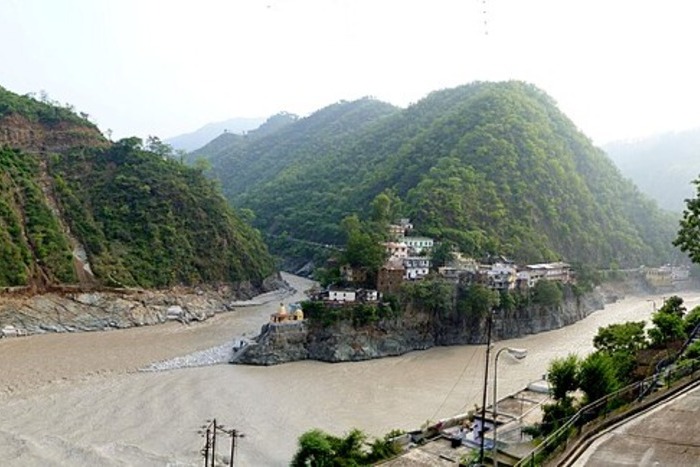The report notes that changing snowfall and rainfall patterns due to climate change have made the Himalayan mountains vulnerable
The recent flash floods in the Uttarkashi district of Uttarakhand reflected multiple brewing threats in the Himalayas, including changing monsoon patterns, increasing glacier melt, and landslide risks. Furthermore, unplanned infrastructure projects in ecologically fragile zones are aggravating the risk, according to an analysis by Climate Trends.
The report came after a giant stream of water came down through the streets of Dharali village in Uttarkashi district, crumbling infrastructure on its way on August 5. Though investigations are still underway, early visuals of the incidents indicated a possible cloudburst that triggered the flash floods. At least four people have been killed, dozens have been swept away, and 190 people have been rescued, according to news reports.
The analysis highlighted that the change in weather patterns due to climate change has made the Himalayan mountains vulnerable. According to the report on the cryosphere by the IPCC, glacial retreat and the melting of permanent frozen grounds have decreased the stability of mountain slopes and the integrity of infrastructure.
Scientists mentioned that the rise in temperatures and humidity in the region has triggered back-to-back extreme weather events.
According to Mahesh Palawat, who is a Vice President-Meteorology and Climate Change of Skymet Weather, said, “A huge influx of moisture from the abnormal warming of oceans increases the capacity of the air to hold more water vapour. The Himalayas act as barriers, which give rise to vertically developed convective clouds, known as cumulonimbus clouds. Sometimes, the vertical height of such clouds might even reach up to 50,000 feet. These clouds are like a column of water, which, when restricted due to topography like the mountains, can lead to the release of water over a smaller area in a shorter duration. This may lead to similar conditions to what we have witnessed in Uttarakhand.”
The rise in torrential monsoon rainfall spells across the Himalayan region can also be attributed to some bigger changes in atmospheric systems in the nearby areas. The Middle East is undergoing an increase in land heating during spring, which is responsible for 46% of the intensified rainfall over Northwest India and Pakistan during 1979–2022. The transition region between the summer monsoon in South Asia and the desert climate in West Asia is shifting northwestward, posing a significantly enhanced risk of floods over Pakistan and northwest India, as cited in the analysis.
Urgency for Monitoring Glaciers
The report also mentioned heightened threats in the Himalayan region. Experts have already warned against the more intense rainfall bringing a greater risk of landslides in high-elevation regions, demanding the development of specific mitigation and adaptation plans at a faster pace. Due to climate change, hazards, such as glacier retreat, permafrost degradation (warming of permanently frozen ground), and lake shrinkage, occur frequently in high-altitude regions, often leading to slope instability and an increase in the occurrence of deep-seated landslides.
The report cited that a total of 127 landslides were detected in the Landsat images of the study area, covering the period from 1999 to 2018. The landslides are mainly concentrated in the Karakoram Mountains, eastern part of the Pamir Mountains, western Himalayas, and south of the Hindu Kush.
Under the global climate change influence, the Himalayas are warming at three times greater than the global average rate. Rising temperatures have intensified the problem by accelerating the melting of Himalayan glaciers and loss of snow cover. This rapid melt fills glacial lakes more quickly, increasing the risk of overflow and downstream flooding. The thinning of glaciers is also contributing to the destabilisation of mountain slopes, according to the report.
“We should have early warning systems and better adaptation designs, which are very much needed at the moment. It is very important to have floodplain zoning and to identify the regions that are extremely prone to flooding. If there is an early warning of extreme precipitation, immediately carry out evacuation from the region under the extreme flood zone. We should learn from how we have handled cyclones. We need to list the places according to the danger levels, and that is how only we can save people,” said Dr Subimal Ghosh, Institute Chair Professor, Department of Civil Engineering & Convener, Interdisciplinary Program in Climate Studies-IIT Mumbai.
About The Author
You may also like
Air Pollution is Changing the Lightning Patterns in India, Study Finds
Temporary CO2 Removal Will Help Offset Methane Emissions: Report
Rise in Fossil Fuel Burning is Making Floods Lethal in Asia
Heatwaves Drove 9% of India’s Power Demand in the Summer of 2024
World Off-Track on Climate Goals as Temperatures are Predicted to Rise: Report

